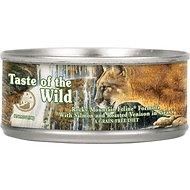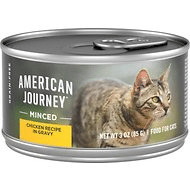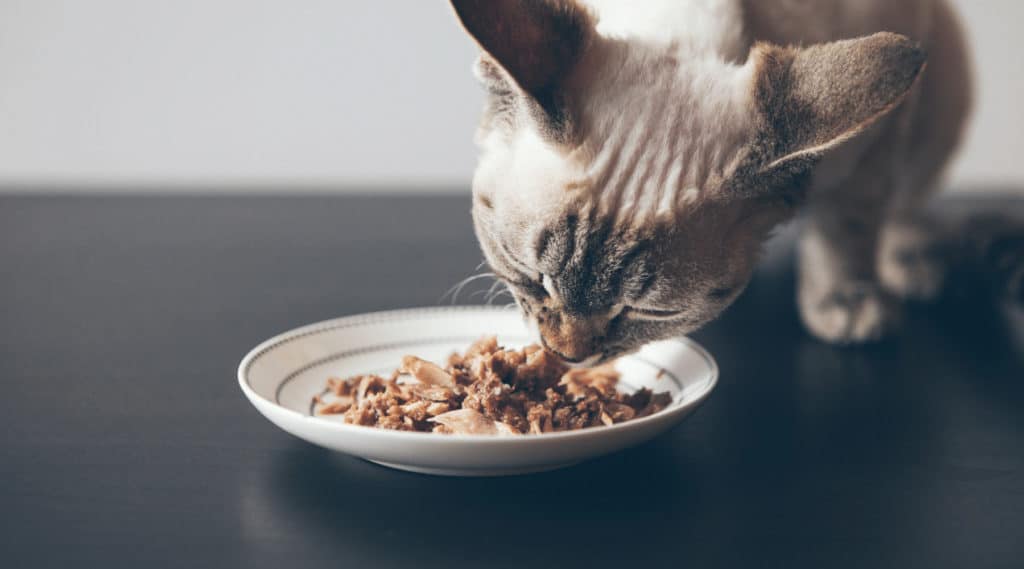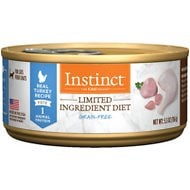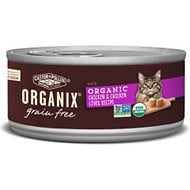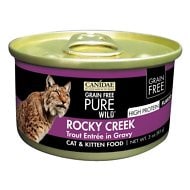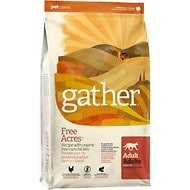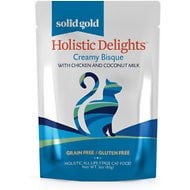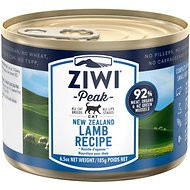Contents
- What Is The Best Food For Pancreatitis in Cats?
- Understanding Pancreatitis in Cats
- Diagnosing and Treating Pancreatitis
- What to Look for in a Good Cat Food for Pancreatitis
- How Do We Make Our Recommendations?
- The 10 Best Foods for Pancreatitis in Cats
- 6 More Top-Rated Cat Foods for Pancreatitis
- Castor & Pollux Organix Grain-Free Organic Chicken & Chicken Liver Canned Food
- Canidae Grain-Free PURE Wild Rocky Creek with Trout Canned Food
- Gather Free Acres Organic Free-Run Chicken Dry Cat Food
- Solid Gold Holistic Delights Creamy Bisque with Chicken & Coconut Milk
- Ziwi Peak Lamb Recipe Canned Cat Food
- Halo Holistic Wild Salmon & Whitefish Recipe Adult Dry Cat Food
- Frequently Asked Questions
Nothing is worse than seeing your cat sick and suffering. The thing many cat owners fail to realize is that by the time their cat shows outward signs of pain or illness, the problem could be fairly advanced. Cats have a natural instinct to hide their pain, so you may not know your cat is sick until it is too late.
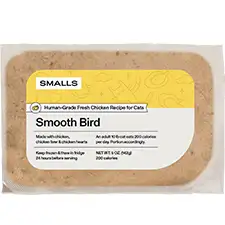
Smalls Human-Grade Ground Bird Fresh Cat Food
- Natural sources of taurine
- High in protein
Pancreatitis is a particularly difficult problem to catch in cats because it is fairly uncommon and its symptoms mimic those of other conditions. Most commonly seen in overweight cats and cats who stop eating for an extended period of time, this condition can lead to serious complications and can even be fatal. With prompt and proper treatment, however, recovery is possible. It all depends how quickly you catch it and get your cat to the vet for treatment.
In this article, we’ll explore the subject of pancreatitis in cats to determine its symptoms, causes, and treatment options. We’ll also talk about potential complications of untreated pancreatitis and explore the role of diet in treatment. You’ll also see our list of top picks for the best food for pancreatitis.
What Is The Best Food For Pancreatitis in Cats?
- Small Ground Bird Human-Grade Fresh Cat Food
- Taste of the Wild Rocky Mountain Grain-Free
- American Journey Salmon & Tuna Recipe in Gravy
- Nature’s Variety LID Grain-Free Real Turkey Recipe
- Castor & Pollux Organix Grain-Free Organic
- Canidae Grain-Free PURE Wild Rocky Creek
- Gather Free Acres Organic Free-Run Chicken
- Solid Gold Holistic Delights Creamy Bisque
- Ziwi Peak Lamb Recipe Canned Cat Food
- Halo Holistic Wild Salmon & Whitefish
Understanding Pancreatitis in Cats
The pancreas is a relatively small organ located between your cat’s stomach and intestines. It only weighs six to eight ounces but its role in your cat’s health is significant. Your cat’s pancreas produces essential hormones called insulin and glucagon that help regulate blood sugar in addition to making the digestive enzymes that help break down the protein, fat, and carbohydrates your cat eats. Because these functions are extremely important, issues with the pancreas can be a big problem.
Untreated pancreatitis can lead to serious problems but the condition itself can be very tricky to diagnose. Many of the most common symptoms of pancreatitis in cats mimic other medical conditions.
Here are some of the primary pancreatitis in cats symptoms:
- Lethargy
- Excessive thirst
- Dehydration
- Increased urination
- Poor appetite
- Weight loss
In humans, vomiting and abdominal pain are common symptoms as well but when it comes to pancreatitis in cats, symptoms like these are less common. If your cat is also suffering from hepatic lipidosis, additional symptoms may include signs of jaundice such as yellow eyes or gums.
Hepatic lipidosis in cats is also known as fatty liver disease and it is one of the most common (and most severe) feline diseases affecting the liver. The liver’s primary functions are to synthesize proteins, detoxify the body, and produce chemicals required for digestion. When a cat goes without eating for an extended period of time, its body starts to break down fat stores as an alternative source of fuel. In humans, this can be a benefit – have you heard of the ketogenic diet? Cats, however, are not designed to convert large stores of fat. As a result, the fat isn’t processed efficiently and it can lead to serious problems in the liver which can trigger severe complications and eventual death.
When it comes to pancreatitis in cats, symptoms can appear minor at first but should not be ignored. The earlier your cat receives treatment, the more likely it is that he will make a full recovery.
Diagnosing and Treating Pancreatitis
The exact cause for most cases of feline pancreatitis is unknown. In many cases, damage to the pancreas is caused by physical trauma, parasite infections, or the ingestion of poisons. In other cases, pancreatitis is secondary to another health problem like liver disease or inflammatory bowel disease. In dogs, a high-fat diet has been linked to pancreatitis but the link between a high-fat diet and pancreatitis in cats is still being explored. What we do know is that there are two types of pancreatitis: acute and chronic.
Acute pancreatitis develops suddenly while chronic pancreatitis is ongoing. In either case, the disease can be either mild or severe. In severe cases, the enzymes produced in the pancreas to digest food may actually start digesting pancreatic tissue. Fortunately, pancreatitis is fairly uncommon, affecting only 2% of the general cat population.
Diagnosing pancreatitis in cats can be tricky not only because the symptoms overlap with other conditions, but because the condition can’t be diagnosed based on medical history or clinical symptoms alone. Add to that the fact that it often develops alongside secondary health problems and you can see the challenge. For years, blood tests to check for high levels of certain enzymes (amylase and lipase) were used as indicators of pancreatic inflammation, but other organs produce these enzymes as well. Elevated white blood cell count may also be present but are not specific to pancreatitis.
The best test currently available for diagnosing pancreatitis measures serum pancreatic lipase immunoreactivity (PLI) as an indicator of pancreatic inflammation. This is a simple blood test and clinical studies show that it correlates very well with pancreatitis.
When it comes to pancreatitis in cats, treatment generally involves supportive care and therapies to address specific symptoms. For example, IV fluids may be administered to treat dehydration and to detoxify the pancreas. Some cats also require medications to control pain and reduce vomiting or antibiotics if the cause is believed to be infectious. Another important aspect of treatment is encouraging the cat to eat.
What to Look for in a Good Cat Food for Pancreatitis
Pancreatitis is a difficult disease to diagnose and treat. Though it is fairly rare, it can become very serious very quickly. On top of supportive therapies such as IV fluids and antibiotics, an important aspect of pancreatitis treatment is getting your cat to start eating again. For cats with low appetite, the key is to find something your cat won’t be able to resist. Generally speaking, that means a cat food made with real animal ingredients so it will be full of natural flavor.
If you’re simply looking for a good cat food to stimulate your cat’s appetite and get him eating again, here are some of the things to look for:
- High quality natural ingredients. If your cat hasn’t eaten for an extended period of time, he may have developed health problems other than pancreatitis. A diet made from high-quality natural ingredients is the best way to get his nutrition back on track. Natural ingredients have higher nutritional value and are more digestible as well.
- Rich in animal protein. Cats have a biological requirement for a high-protein diet and most of that should come from animal products. In addition to being rich in protein, animal ingredients are also more appealing to cats because they are rich in real meat flavor.
- High in moisture content. Many cats with pancreatitis suffer from dehydration, so switching to a canned food or adding a moist cat food topper to your cat’s diet can help him rehydrate. Canned foods are also more appealing to many cats due to their texture, smell, and flavor.
- Moderate fat content. In dogs, high-fat diets are linked to pancreatitis but the same does not appear to be true for cats. This being the case, you should feed your cat a diet with moderate fat content to meet his needs for essential fatty acids without going overboard on calories.
- Limited carbohydrate content. Cats are not built to digest carbohydrates as efficiently as animal ingredients, so a diet high in carbohydrates may overtax the pancreas. Look for a recipe with limited content of digestible carbohydrates like whole grains and vegetables.
- Optimized calorie content. Cats that are overweight or obese have a higher risk of developing pancreatitis. On the flip side, cats with pancreatitis often lose an unhealthy amount of weight due to low appetite. Depending on your cat’s individual situation, you may want to choose a cat food that is calorie-limited or one that is calorie-dense.
Now that you have a better understanding of pancreatitis in cats and the role diet may play in your cat’s recovery, you’re ready to start shopping. If you need additional guidance, check out our top picks below but read how we make our recommendations first.
How Do We Make Our Recommendations?
Cats are obligate carnivores which means that they have a biological requirement for a high-protein diet. Cats in the wild subsist primarily on animal meat, consuming little plant matter in the stomach contents of their prey. Keeping these dietary requirements in mind, we only recommend cat foods that are rich in animal protein with limited carbohydrate content. We tend to favor recipes that contain a real source of animal protein as the first ingredient (or first several ingredients) that is also rich in animal-based fats. Complete and balanced nutrition is essential as well, so we also look for recipes fortified with essential vitamins and minerals and consider beneficial supplements like probiotics a bonus.
Here are some of the requirements for a cat food to receive our recommendation:
- A source of high-quality animal protein as the first ingredient
- At least 30% crude protein for kittens and at least 26% for adults
- A minimum of 9% crude fat for kittens and adults
- A balance of omega-3 and omega-6 fatty acids, primarily from animal sources
- A rich blend of nutrients from natural sources and supplements, as needed
- Limited carbohydrate content from digestible sources (like whole grains and veggies)
- No low-quality fillers, by-products, or artificial additives (preservatives, dyes, or flavors)
The 10 Best Foods for Pancreatitis in Cats
If your cat suffers from pancreatitis, you need to seek veterinary help as soon as possible. Your vet will be able to determine the severity of your cat’s condition and recommend a course of treatment. On top of that treatment, you may want to change your cat’s diet to encourage him to start eating again and to help him regain his health. If you need a little help picking the right cat food to help your cat recover from pancreatitis, here are our top picks for the best food for pancreatitis support:
| Our 2024 Picks: Best Foods for Pancreatitis in Cats | |||
Small Ground Bird Human-Grade Fresh Cat Food
|
CHECK PRICE | ||
Taste Of The Wild Rocky Mountain Grain-Free
|
CHECK PRICE | ||
American Journey Minced Chicken Recipe In Gravy
|
CHECK PRICE | ||
Nature’s Variety LID Grain-Free Real Turkey Recipe
|
CHECK PRICE | ||
Castor & Pollux Organix Grain-Free Organic
|
CHECK PRICE | ||
Canidae Grain-Free PURE Wild Rocky Creek
|
CHECK PRICE | ||
Gather Free Acres Organic Free-Run Chicken Dry Cat Food
|
CHECK PRICE | ||
Solid Gold Holistic Delights Creamy Bisque
|
CHECK PRICE | ||
Ziwi Peak Lamb Recipe Canned Cat Food
|
CHECK PRICE | ||
Halo Holistic Wild Salmon & Whitefish Recipe
|
CHECK PRICE | ||
Small Ground Bird Human-Grade Fresh Cat Food
Overall Best Food for Pancreatitis: When it comes to restoring your cat’s health, a nutrient-rich diet made from real, whole-food ingredients is essential. Many pet nutrition experts agree that fresh food is best which is why Smalls is our top pick. This is a fresh cat food company that prepares wholesome, all-natural cat food in small batches and ships it fresh right to your door. Each recipe features real animal protein as the main ingredient with other whole-food ingredients to ensure complete and balanced nutrition. Because the food is fresh, it is rich in moisture and it offers a more palatable texture for cats with low appetite. Smalls calculates your cat’s calorie requirements and sends you pre-portioned packages of the food. Plus, because it is shipped fresh, there is no need for artificial preservatives and the recipes are completely free from low-quality fillers and by-products. Simply put, Smalls is high-quality, fresh cat food that will meet your cat’s nutritional needs.
- Pros: Made from fresh natural ingredients, rich in real animal protein and flavor, high in moisture content, highly digestible, more palatable for cats with low appetite, customized calorie content
- Cons: Only two recipes to choose from, significantly more expensive than traditional kibble
Taste of the Wild Rocky Mountain Grain-Free Canned Food
Most Popular Cat Food for Pancreatitis:Because there are so many different brands of cat food out there, it can be difficult to choose just one. For cats with pancreatitis, digestibility and flavor are key. If you’re not sure which brand to choose, go with a popular choice like Taste of the Wild, known for using premium roasted meats in all of their recipes. This Rocky Mountain canned food recipe features fresh salmon as the main ingredient with chicken liver, chicken, smoked salmon, and roasted venison as nutrient- and flavor-rich supplemental proteins. With fish broth and chicken broth as main ingredients, this recipe is also rich in moisture. Overall, this recipe is nutritionally complete with the help from fresh fruits and vegetables to provide natural sources of key nutrients and vitamin and chelated mineral supplements for nutritional balance.
- Pros: Numerous sources of real animal protein, rich in moisture and meat flavor, fresh fruits and vegetable, highly digestible, supplemented with vitamins and chelated minerals
- Cons: May be too high in fiber for some cats, primary source of fat is plant-based (sunflower oil)
American Journey Salmon & Tuna Recipe in Gravy Grain-Free Canned Food
Most Affordable Cat Food for Pancreatitis: When shopping for cat food, you’ll notice that there is a big discrepancy in pricing. Choosing a high-quality recipe for your cat is important to help him recover from pancreatitis, but you don’t necessarily need to spend a fortune for it. This American Journey Salmon & Tuna Recipe in Gravy Grain-Free Canned Food is a great option because not only is it affordable, but it is rich in premium animal protein and real fish flavor. This moisture-rich recipe contains bits of real salmon in flavorful gravy to appeal to your cat’s appetite while delivering highly digestible sources of nutrition. It doesn’t contain any grains, fillers, or by-products and it is rich in omega-3 and omega-6 fatty acids for skin and coat support. All in all, this recipe provides a dry matter calculation of 50% protein and 19% fat.
- Pros: Real salmon first ingredient, rich in moisture and fish flavor, blend of omega-3 and omega-6 fatty acids, highly digestible natural ingredients, complete and balanced nutrition
- Cons: May not be high enough in calories for underweight cats
Nature’s Variety LID Grain-Free Real Turkey Recipe
Best Food for Pancreatitis and Sensitive Stomach:If your cat suffers from pancreatitis, you want to choose a cat food that will stimulate his appetite and help him recover his health. It can be an added challenge to find the right cat food if your cat also has a sensitive stomach or food allergies. This Instinct by Nature’s Variety LID Grain-Free Real Turkey Recipe canned food is a great choice because it is made with a single source of novel animal protein and contains a limited number of main ingredients. Fresh turkey is the first ingredient, followed by turkey broth and turkey liver – both of these ingredients add a boost of moisture and real turkey flavor. This recipe contains only high-quality natural ingredients with the help of vitamins and chelated mineral supplements to ensure complete and balanced nutrition.
- Pros: Real turkey first ingredient, single source of novel protein, limited number of ingredients, highly digestible natural recipe, rich in moisture content, complete and balance
- Cons: Contains some plant protein (pea protein), may be too high in fiber for some cats
6 More Top-Rated Cat Foods for Pancreatitis
Castor & Pollux Organix Grain-Free Organic Chicken & Chicken Liver Canned Food
Quality is key if you’re trying to help your cat recover from pancreatitis, but you also need something rich in flavor that will stimulate his appetite. This Castor & Pollux Organix Grain-Free Organic Chicken & Chicken Liver is the perfect balance because it features organic free-range chicken as the main ingredient. This is a high-quality source of animal protein that is also rich in flavor. This recipe contains other natural ingredients like organic chicken liver, organic coconut flour, and organic flaxseed as well as fresh fruits and vegetables to provide natural sources for key nutrients. Calculated as dry matter, this recipe contains nearly 41% protein and 23% fat.
Canidae Grain-Free PURE Wild Rocky Creek with Trout Canned Food
If you’re looking for a nutritious canned food option to feed your cat, consider this Canidae Grain-Free PURE Wild Rocky Creek. It features real trout as the main ingredient with fish broth for flavor and moisture. It is a high-protein recipe made with real, natural ingredients that is easy on your cat’s digestion and full of healthy energy. This recipe contains added taurine for healthy heart function and immune strength as well, to help your cat recover from pancreatitis. Plus, it is fortified with essential vitamins and chelated minerals to ensure complete and balanced nutrition.
Gather Free Acres Organic Free-Run Chicken Dry Cat Food
Some cats simply prefer dry food, or perhaps you prefer it yourself due to the increased convenience. If you’re looking for a premium dry food to feed your cat, consider this Gather Free Acres Organic Free-Run Chicken Dry Cat Food. It features organic free-run chicken as the main ingredient and a single source of real animal protein. With non-GMO vegetables and fruits to deliver natural sources for key nutrients, this recipe is highly digestible and nutrient-rich. It contains a rich blend of omega-3 and omega-6 fatty acids for healthy skin and coat, plus it is rich in fiber for healthy digestion. Overall, this recipe provides 30% protein and 16% fat at 403 calories per cup.
Solid Gold Holistic Delights Creamy Bisque with Chicken & Coconut Milk
If you decide to feed your cat dry food but still want to increase the moisture content of his diet, consider a wet food topper like this Solid Gold Holistic Delights Creamy Bisque. This is holistic natural recipe featuring fresh chicken as the main ingredient with tuna as a supplemental source of animal protein. It is loaded with moisture and real meat flavor, supplemented with carrot and potato as digestible carbohydrates and natural sources for key nutrients. Best of all, this recipe is complete and balanced so you can use it as your cat’s main diet or as a meal topper.
Ziwi Peak Lamb Recipe Canned Cat Food
The best diet for any cat is one that is rich in real animal protein and low in carbohydrates. This Ziwi Peak Lamb Recipe Canned Cat Food meets both of those requirements and more. It features free-range, grass-fed lamb as a single source of novel animal protein, making it a great choice for cats with food allergies or sensitivities. It also contains lamb organs and bone for natural meat flavor and optimal nutrition. This recipe contains plenty of moisture and is fortified with vitamins and chelated minerals to ensure complete and balanced nutrition for your cat.
Halo Holistic Wild Salmon & Whitefish Recipe Adult Dry Cat Food
A delicious source of holistic, natural nutrition for your cat is this Halo Holistic Wild Salmon & Whitefish Recipe. This formula features real, whole salmon and whitefish as flavor-rich sources of real animal protein. It contains whole-grain carbohydrates for maximum digestibility and a rich blend of omega-3 and omega-6 fatty acids. This recipe contains dried fruits and vegetables to provide natural sources for key nutrients with vitamin and chelated mineral supplements to ensure complete and balanced nutrition. Overall, this recipe provides 32% protein and 16% fat at 410 calories per cup.
Frequently Asked Questions
- Can a cat live with pancreatitis? Pancreatitis is a fairly rare condition, affecting only about 2% of cats in the general population. In some cases it can be mild, but severe cases can become serious very quickly. The problem with pancreatitis is that it occurs when a cat fails to eat for an extended period of time. As you can imagine, this leads to other health problems as well. A cat might be able to live with mild pancreatitis for some time, but his health will steadily decline and his condition will worsen rapidly if he doesn’t eat.
- Is pancreatitis painful in cats? The underlying cause of pancreatitis in cats is unknown, but it can be caused by intestinal parasites, physical trauma, or the ingestion of toxic substances. Each of these causes is correlated with its own set of symptoms which could be painful for your cat. For the most part, however, pancreatitis symptoms include lethargy, dehydration, and weight loss.
- How do they test for pancreatitis in cats? Diagnosing pancreatitis is very challenging because its symptoms mimic those of a variety of other conditions and many cats develop concurrent health issues like hepatic lipidosis or irritable bowel syndrome. The best test for pancreatitis in cats measures serum pancreatic lipase immunoreactivity (PLI) as an indicator of pancreatic inflammation. This is a blood test and a number of clinical studies show that it correlates very well with pancreatitis.
- How do you treat pancreatitis naturally? In severe cases of pancreatitis, the cat’s body might start breaking down pancreas tissue. This is a very serious problem and can lead to complications or death if left untreated. Many cats with pancreatitis require supportive therapies like IV fluids or feeding as well as medications for pain and vomiting. In terms of how to treat pancreatitis in cats at home, there is no substitute for veterinary care for this disease. You can, however, support your cat’s recovery by getting him to eat as soon as possible once he comes home from the vet. Feeding him a healthy cat food rich in moisture and protein is a good idea.
- How long does it take to recover from pancreatitis? When it comes to pancreatitis in cats, recovery time varies according to the severity of the condition. Mild cases may resolve on their own with prompt treatment as long as the cat resumes eating. In more severe cases, treatment may take several weeks, and the cat may require IV fluids or a feeding tube to keep him healthy while he recovers.
Cats can’t tell you when they are feeling unwell and they are likely to try to hide their pain as long as possible. As a cat owner, it is your job to know what kind of behavior is normal for your cat and to seek veterinary care if you notice behavioral changes which might indicate a health problem. Lethargy, increased thirst, and unexplained weight loss are all potential causes for concern and should be addressed quickly with your veterinarian.
Your veterinarian will be able to test your cat for pancreatitis and, if he has it, recommend a course of treatment appropriate for the severity of his condition. In addition to following your vet’s advice, you should feed your cat a healthy, highly digestible diet that stimulates his appetite to help him recover his strength and to stop the damaging processes that lead to pancreatitis.
Cat foods are a dime a dozen, but some are better than others. If you’re not quite sure what you’re looking for, check out our recommendations above. Good luck!

